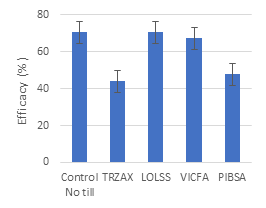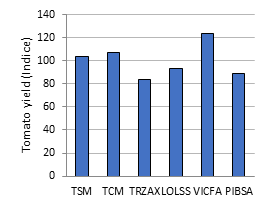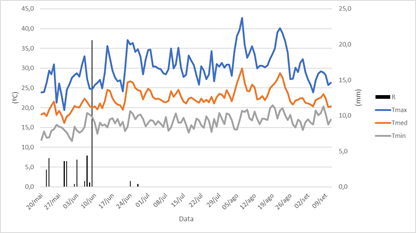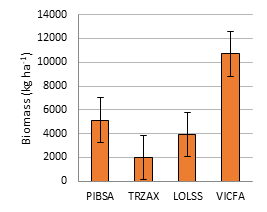INTRODUCTION
Processed tomatoes are the most economically important horticultural crop in Portugal. Monoculture is very common in the Lezíria Tejo region. The “European Green Deal” aims to guarantee the sustainability of production systems, reduce the environmental footprint of food systems, and strengthen resilience against crises and to ensure healthy and accessible food. The "Farm to Fork" EU strategy proposes reducing the amount of pesticides used by around 50% by 2030; promoting the biodiversity of agro-ecosystems; combating climate change through carbon neutrality; increasing soil fertility by encouraging technologies that promote carbon sequestration in the soil. One of the technologies that contributes to the sustainability of crop production systems is the installation of cover crops (CC), i.e. the installation of a crop between two main crops. In the region's irrigated systems, the main crop is almost always considered to be in spring-summer. Thus, CC is installed at the beginning of the agricultural year (autumn) to be harvested and/or incorporated into the soil at the end of winter or beginning of spring. Different crop family (Poaceae, Fabaceae, Brassicaceae, Asteraceae) can be chosen and species selected either for single cropping or for mixtures. This technology can be associated with the conservation agriculture system, when CC residues are left in the soil, covering more than 30% of the soil surface. CCs have several advantages, whether from an agronomic, environmental and/or economic point of view. They can contribute to reducing nitrate leaching improving soil fertility by reducing erosion, increasing the soil's OM content and improving its structure increasing biodiversity in the agro-system. Another important advantage of CC is its potential to control certain weed species (Lemessa & Wakjira, 2015; Sias et al., 2021). In Portugal, several research projects have been carried out to assess the positive externalities of introducing CC into horticultural and/or maize monoculture production systems (MaisSolo; Hortinf; Horticover; SoilLife projects). However, given the enormous diversity of factors that can influence the impact of CC on weed control (crop to be planted; soil type and fertility; climatic conditions; cultural succession; installation technologies; production system; soil seed bank) it is necessary to establish and increase knowledge on the impact and its effect on weed vegetation. The aim of this study was to to investigate weed suppression potential of winter planted cover crops and their effect on subsequent processed tomato yield.
MATERIAL AND METHODS
In January 2023, a set of cover crops (CC) were sown in an experimental field located in Quinta do Galinheiro, Santarém (39º15'6.21''N; 8º42'6.13''W) where a three year rotation have been implemented since 2020. The experimental design was a randomized complete block with six treatments and three replications. Treatments included four winter-planted CC: Tri -wheat (Triticum aestivum L.); A - ryegrass (Lolium multiflorum Lam.); F -faba bean (Vicia faba L.); E - peas (Pisum sativum L.); and two control plots without CC: TCmob -with tillage; TSm - without tillage. The preceding crop for the CCs was maize, which was also planted in a direct seeding system in spring 2022. The maize residues were shredded and kept on the soil surface. The field trial was carried out on a Eutric Cambisol (FAO, 1978) with a sandy-white texture (83.6% sand, 9.1 % silt, 7.3 % clay), a low OM content (1.9%) and high level of assimilable phosphorus and potassium (411 mg kg-1 P2O5 and 68 mg kg-1 K2O) and a low cation exchange capacity (4.52 me 100 g-1).The graph in Figure 1 shows the thermopluviogram based on the daily averages of maximum, average and minimum temperature and accumulated daily rainfall for the period from 20th May to 11th September 2023.
Cover crops were installed manually at the end of 2023, in no tillage system. The seeding density was 40 kg ha-1 (ryegrass), 160 kg ha-1 (wheat), 80 seeds m-2 (peas) and 20 seeds m-2 (faba bean). CC were not fertilized nor irrigated. For biomass samples (0.25 m2) were collected in mid-May in each plot. The pelargonic acid herbicide (Belouka, 7% a.i., Belchim) was applied (600 cp L ha-1) prior to installation of tomato crop. The tomato total fertilization ranged 150 kg ha-1 of N, 105 kg ha-1 of P2O5 and 150 kg ha-1 of K2O. Manual planting of the ‘H1015’ tomato cultivar was carried out on June 1st, at a density of 3.33 plants m-2. Three fungicide treatments were applied. Circa 110 days after planting, four plants were harvested per treatment and repetition to determine the number and weight of total and commercial fruits. At the same time, weeds were collected in the plot central line (0.25 m2), identified and separated by species and dry biomass was determined.
RESULTS AND DISCUSSION
Cover crop aboveground biomass (dry weight) ranged from 580 kg ha-1 (T. aestivum) to 2,393 kg ha−1 (Vicia faba) - Figure 2. The biomass of Fabaceae cover crops was significantly higher than that of Poaceae (F=21.5634; P< 0.001). Particularly noteworthy was Vicia faba with 10,696±2,393 kg ha-1 compared to Pisum sativum with half of the biomass (5,125±1,805 kg ha-1) - Figure 2. Main weeds in tomato crop ranked in importance Cyperus rotundus L., Setaria verticillata (L.)P.Beauv., Digitaria sanguinalis (L.)Scop., Portulaca oleracea L. and Heliotropium europaeum L.- Table 1.
Table 1 Weed species density and mean relative abundance registed in the cover crop treatments
| Mean relative abundance (%) | ||||||||||
| Cover crop treatment | Total density (pl/m2) | Cyperus sp. | Setaria sp. | Digitaria sanguinalis | Heliotropium europaeum | Portulaca oleracea | Other broadleaves | Annual grasses | Annual broadleaves | Perennial weeds |
| Control No till | 73 | 11 | 7 | 2 | 7 | 0 | 18 | 9 | 73 | 14 |
| Control + till | 330 | 5 | 0 | 0 | 0 | 2 | 5 | 2 | 330 | 47.25 |
| Triticum aestivum | 141 | 9 | 25 | 4 | 11 | 0 | 34 | 14 | 141 | 26.5 |
| Lolium multiflorum | 77 | 23 | 0 | 0 | 0 | 0 | 23 | 0 | 77 | 14 |
| Vicia faba | 96 | 14 | 0 | 0 | 0 | 0 | 14 | 0 | 96 | 15.5 |
| Pisum sativum | 166 | 4 | 4 | 0 | 4 | 0 | 7 | 4 | 166 | 24.75 |
Weed density was reduced between 44% and 70% with cover crop relative to tillage -Figures 3 and 4. Lolium multiflorum and Vicia faba were also more effective in reducing the weed biomass - Figure 3. The success of cover cropping as weed management measures depends on a complex of factors, including species selection, crop management (nitrogen and water availability) and, in particular, termination methods: mowing, roller-crimping, shredding, burying or natural mulching. (Rouge et al., 2022; Wang et al., 2022).
Vicia faba as a green manuring cover crop was effective in controlling annual weeds in maize as the following crop (Amaranthus retroflexus L., Chenopodium album L., Solanum nigrum L. and D. sanguinalis) as well as perennial weeds such as nutsedge (C. rotundus) (Álvarez-Iglesias et al., 2018). Which corroborates the results of our study, where V. faba was shredded at harvest and used as natural mulching. Lolium multiflorum in certain conditions could exerts allelopathic effects (San Emeterio et al., 2004). So several mechanisms acting for weed control could be expected.


Figure 3 Effect of cover crops compared to no cover crop (Control, no till and Control + till) in terms of weed biomass and weed density (A) and Efficay of CC on weeds up to 7 wk after planting of main crop (tomato) (B) CC-PIBSA (Pisum sativum); VICFA (Vicia faba); LOLSS (Lolium multiflorum); TRZAX (Triticum aestivum).
Contrary to expectations Poaceae cover crops were not the most effective in suppressing weeds, compared to Fabaceae. Vicia faba had the highest effect on weed population density relative to the bareground control (Control no till) and also contributed to higher productivity in the processed tomato - Figure 3.


////Figure 4 Weed suppression across CC biomass per species PIBSA (Pisum sativum); LOLSS (Lolium multiflorum); TRZAX (Triticum aestivum) VICFA (Vicia faba) (A) and effect of winter cover crops on subsequent processed tomato yield (B).
Tomato productivity (yield index, %) ranged from 84 % (T. aestivum) to 123% (V. faba) and the previous cover crop does not affect tomato yield (F=0.6692; P > 0,05)- Figure 4B. According to Sias et al. (2021) the release of allelochemicals promotes changes in the soil, altering the balance of microorganisms in the rhizosphere of the main crop and weed species, contributing to the impoverishment of the latter.
CONCLUSION
Vicia faba was the most effective cover crop for weed management in our study. It contributed with the higher biomass for soil cover. The mechanisms that contribute for weed control either soil cover or allelopathy, were not studied. From literature it is known that total phenolics content of roots and stems significantly contributed to V. faba allelopathy. However the use of V. faba as a cover crop preceding tomato did not carried a risk of allelopathic effects, which did not have a negative impact on tomato yield.
















